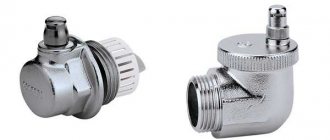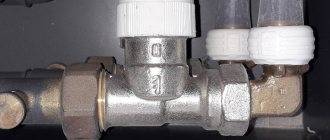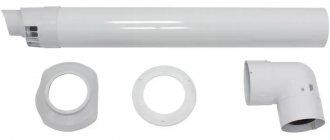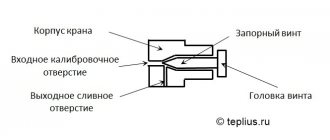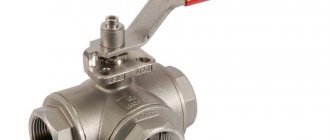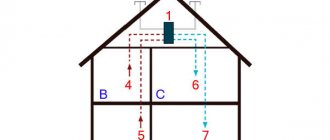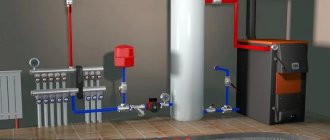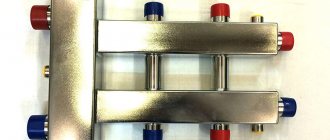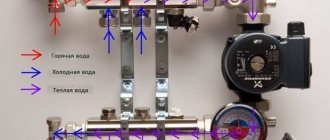A common reason for incomplete heating of radiators or poor water pressure is air locks. The Mayevsky valve is designed to bleed air in a heating or water supply system. The principle of operation of the valves is clear and the same - together with a small amount of media, atmospheric accumulations come out, freeing up space for heated water. However, today there are a large number of their varieties, prices and designs, which we will discuss in detail in this review.
Cold areas of batteries are a sign of air accumulation.
However, the types and operation of models vary. Self-installation also requires detailed instructions. About everything later in the article.
Why systems become aired and how Mayevsky’s automatic air vents work
The accumulation of air masses occurs for several reasons:
- The pipework is installed incorrectly. Numerous bends in a small, limited space have to be formed into loops turned upward.
Laying heating pipes in a private house
They are capable of trapping air. It is important to think through the heating and water supply scheme in advance and/or leave the design of home networks to professionals. But even in a masterfully calculated scheme, a Mayevsky crane is required. The operating principle of the design will allow you to remove the air yourself, without resorting to the services of specialists.
- Filling the system with insufficient supply pressure. The slow pressure will “air” the vertical risers and the far corners of the heating radiators. If the pump power in an autonomous home heating or water supply is not enough, it is recommended to connect an additional unit.
- A carrier supersaturated with oxygen.
Water saturated with oxygen
Typically, such water enters the pipes from a common treatment pond, which indicates a malfunction of the equipment - low power of pumps, old pipes, etc.
Periodic repair work with a stop in heat or water supply can also cause airing of the main line. This is indicated by poor pressure, sharp sounds or cold areas of the radiators, respectively. It is important to bleed air regularly if such situations are not uncommon.
Carrying out repair work
If you discover signs of air in the heating system, you should not immediately start getting rid of it. First, check the circuit for integrity and tightness. After all, if there are leaks, problems will continue.
Coolant leak
Coolant leakage is the loss of fluid that occurs due to loose connections and damage to the circuit.
Photo 1. Leak in the heating system pipe. Such a problem can cause poor operation of the heating structure.
Possible leak locations and solutions:
- Pipe sections. To stop the leak, clamps and cold welding are used. If the pipe is plastic, the entire section is replaced.
- The joints between parts of the system are sealed. Welding is used.
- Loose connection of radiator sections. You will have to remove the battery and tighten the connections (on aluminum). Cast iron radiators are glued with a cloth containing epoxy resin.
This is a labor-intensive part of the work of preparing the system for the heating season. But this must be done, otherwise you may be left without heat in winter.
A constant loss of coolant will lead to unstable operation of the system.
Features of the underfloor heating system
The presence of a heated floor complicates the system; it is not easy to remove air from the floor loops.
Air plugs appear due to:
- reducing pressure;
- strong heating of the coolant;
- leak formation;
- violation of the tightness of connections;
- errors made during installation (uneven surface, pipe slope, errors in the organization of the collector);
- illiterate first launch of the system.
In order for the system to start correctly, the air is bled from it before the boiler is turned on and the coolant is heated.
If a warm floor is the main means of obtaining a comfortable temperature, then air should not be allowed into it.
Attention! A conventional system works even if there is air there. The efficiency will decrease , but heat will still flow. When air appears in the circuit, the floor will stop heating - the reason for this is the complex installation and small diameter of the pipeline.
Removing air from the floor circuit is a lengthy process:
- Only one circuit on the collector is turned on
- The pressure is built up above the working pressure ( by 15-20% ).
- The circulation pump starts at low speed. It takes some time to fill the circuit so that the coolant displaces the air. Then the next circuit is activated, so one by one all the branches passing through the collector are slowly filled.
- The process lasts several days. This is repeated until all the air is released.
- This is done with cold coolant ; heating is turned on only when it is certain that the air has completely escaped.
Reference. When installing the system, it is useful to think about equipping the floor circuit with a separator - a device for automatically removing air from the pipes.
Coolant renewal frequency
Liquid is an important component of heating that must be used correctly.
Periodic replacement is necessary, but should not be overused. The optimal shelf life of liquid in pipes is 12 months, subject to mandatory draining of the system.
Synthetic coolants: propylene glycol, ethylene glycol remain in the system for up to 7-8 years.
Photo 2. Canister with synthetic coolant for the heating system. This substance lasts longer than ordinary water.
The concentration of synthetic compounds in the liquid extends the shelf life of the coolant. But if there is no need to use antifreeze , then you can get by with plain water.
The replacement time will be determined by coarse filters: if they do not need to be washed and replaced, then the water in the system is also suitable and does not need to be changed.
This is important because each fresh portion of liquid is a fresh set of salts and impurities, oxygen, which reacts with new forces with internal surfaces, settling on them in layers that gradually reduce the efficiency of the system.
Important! The water that is already in the circuit is a prepared liquid , without impurities and active substances. The fact that the water has changed color does not change its value - it has already undergone reactions, become inert and is now an optimal addition to the efficiency of the system.
The principle of operation of the Mayevsky crane: photos of installation sites, types and types of valves
In the design of the Mayevsky tap, a screw with ducts is responsible for bleeding off excess air in radiators and pipes.
Bleeding air from the heated towel rail
By turning it to the desired position, you can open or close the holes. Valves are classified according to their location and operating principles - manual or automatic. More information about the types and installation principles of each:
Classic Mayevsky tap with thread
Made from brass, a material highly resistant to corrosion. Installed on any section of the pipeline if the piping layout is complex and tortuous.
A complex heating circuit requires a Mayevsky crane at the transitions of vertical to horizontal sections
Related article: Thermostat for a heating radiator. This article describes the design options for these devices, methods of their installation, as well as several popular models of thermostats with prices and characteristics to make your choice easier.
To install in a radiator or on a pipe, you need to drill a hole and tap a thread inside the radiator or pipe/riser wall.
Mayevsky radiator tap
Accordingly, it is installed on radiators. It is a metal structure with a plastic rotating cap. These drains are intended for heating appliances only.
Modern “batteries” already have the ability to install Mayevsky cranes or are even sold complete with them.
Radiator drain installation location
Mayevsky ball valve: principle of operation
Hybrid networks use a ball valve. The operating principle is as follows: instead of a screw, the design has a rotating ball with a hole equal to the passage channel. The seals inside the valve ensure reliability in the closed position.
Sectional view of ball valve
The principle of operation and installation is similar to the designs described above.
Automatic crane
The drain has an internal cylinder with a float.
Operating principle of an automatic air release valve - cross-sectional diagram
The operating principle of an automatic heating air vent is simple: when the cavity is filled with air, the mass is released through the built-in valve. The loss of pressure causes the float to move upward, which causes it to block the outlet, and the coolant does not drain. Comfortable? Without a doubt. However, such a valve system is only suitable for perfectly clean water - purified, circulating through an autonomous system. Centralized networks are full of garbage - scale, solid rock particles, sand and other dirt. They are usually installed in a home heating system, where the water is filtered by a special pump compartment and where manual air release is difficult.
Mayevsky tap with safety valve
The safety valve will preserve the plastic pipework.
The device is activated automatically if the air pressure in the pipes exceeds the maximum permissible level - usually 16 bar, which threatens to rupture the joints. The device is especially relevant for a home network made of plastic pipes.
Important! Bleeding air from an autonomous home water or heat supply network should be carried out only after turning off the circulation pump. For clarity, here is a video of how the Mayevsky crane works.
Video review: what to do if the batteries do not heat well
Criterias of choice
To decide whether the installation of a Mayevsky tap is necessary, consider whether the air can independently escape from the pipes and heating radiators. Consider the laws of physics: air can only flow upward from pipes and radiators. Based on this parameter, you can choose which device is better.
To select a suitable model, you should also take into account the material of the pipes, the availability of free access to the installation site and the nuances of servicing the mechanism.
Basic expert advice on selection criteria:
- In houses with centralized heating, it is advisable to install manual models or taps with fuses, which will help protect the system from water hammer. To prevent clogging, automatic taps can be installed in home systems where purified coolant circulates.
- Even in a home system, only manual taps can be installed on cast iron batteries.
- For plastic pipes, choose models with a fuse. This protects the mechanism from damage due to water hammer.
- In hard-to-reach places, it is worth installing an automatic model or a manual faucet with a valve.
- When purchasing a valve, it is important to pay attention to the material from which it is made. The design with a brass body will last the longest: this material is resistant to corrosion.
- The type of product, maximum load and compliance with the type of communications are reflected in the documentation for the model, so it is important to study the instructions when purchasing.
How to choose the right Mayevsky crane
Automation is tempting, however, buying a Mayevsky crane with an operating mechanism that does not require human intervention is not always rational. How to choose the right one:
- Autonomous or centralized networks require different types of Mayevsky cranes, the operating principles of which are similar and understandable. In home wiring, it is convenient to use an automated design, since there is much less debris in the water supplied by a circulation pump from a well than in urban residential networks.
Old equipment = dirty coolant
Important! Central heating must be able to clear the taps from gaps, otherwise incorrect operation is guaranteed.
- Complex weaving networks will require several cranes, including automatic and mechanical. It is important to evaluate the possibility of unhindered control of the ball valve if the heating elements are located in a confined space.
The ball valve handle should rotate freely
- Also, automation is installed where it is impossible or difficult to work - the top of risers, a hidden system under the floor, passing pipes in the wall and other hard-to-reach places.
- Automatic taps are sensitive to high temperatures. If the carrier parameter exceeds 150⁰, then mechanics are preferable.
- Safety valves on Mayevsky taps will protect polyvinyl chloride pipes in an apartment or house from water hammer - a common problem with central heating with pressure fluctuations and interruptions in the heat supply.
The drain check valve will save plastic pipes from water hammer.
The price of Mayevsky taps is insignificant in comparison with the benefits of the mechanism.
Selecting a valve based on technical parameters
The standard sizes of Mayevsky taps are 15 and 20 mm, ½″ and ¾″ - corresponding to the diameters of the pipes and the top points of the radiators. The operating pressure of private home heating is 10 bar, in an apartment building - up to 16 bar. In both cases, devices must be purchased with a pressure reserve, taking into account possible differences and water hammer.
Advice for business
Before deciding to purchase air exhaust devices, it is recommended to carefully study the arrangement of devices in the heating circuit.
Depending on the degree of freedom of access to the equipment, Mayevsky cranes of a suitable modification should be installed.
Where it is difficult to work with a screwdriver, turnkey models are better suited, and where it is difficult to work with keys, it is wise to place automatic devices. Careful analysis will help make device maintenance more efficient and save on purchases.
Manual devices have the most simplified design, for example, compared to automatic air vents. But, as practice shows, simplicity is the key to reliability.
If cast iron radiators are used in the heating system, manual taps are more reliable for such a system than automatic ones. Meanwhile, the degree of reliability of the design largely depends on the quality of the metal (brass) from which the air vent is made.
Do-it-yourself Mayevsky crane installation, adjustment, operation
The installation process is simple even for beginners without experience, home craftsmen. The following tools will be required:
- Mayevsky crane - automatic or mechanical. The manufacturer, as a rule, offers a complete set with rubber seals. It is recommended to check the model immediately in the store - the screw should turn freely, the key - square or with a flat end, like a screwdriver - should fit easily into the groove.
- Tape-fum. Professional locksmiths recommend using additional sealing materials for sealing. Water hammer can cause a fistula in the gasket.
- An adjustable wrench will be needed to unscrew or replace the old valve. A screwdriver is needed if the plumbing faucet kit does not have a key to turn the screw.
Table 1. Do-it-yourself installation of the Mayevsky crane
| Job title | Photo | Description |
| Preparation |
| Before installation, the water from the radiators is completely drained. The autonomous system has special shut-off valves on the supply for this purpose. Apartment risers are blocked by building management workers. |
| Installation |
| The work consists of unscrewing the plug on the radiator and installing a valve in its place to remove air. To seal, fum tape is screwed onto the thread, gaskets are installed and the valve is screwed on. Many modern radiators already include keys for Mayevsky taps. Also, to turn the screws, use a simple flat-head screwdriver inserted into the notch on the valve. |
| Adjustment |
| After installation, the radiators are filled with coolant, and the joint between them and the Mayevsky tap is checked for leaks. Emerging drops and even leaks are a reason to tighten the nut with a wrench until the release of moisture completely stops. |
| Exploitation |
| Next, after the system is completely filled with coolant or cold water, if there are no complaints, tests are carried out with the coolant, turning the valve key in the required direction. |
| Installation of a Mayevsky tap on cast iron radiators |
| Classic Mayevsky taps can be used for cast iron radiators, given the complexity of the installation. It consists of drilling a hole of the required diameter on the top plug and cutting the thread with a special tool - a drill. Further, the installation does not differ from that described above. |
| Models of taps for cast iron radiators |
| Difficulties will arise in the constant clogging of the tap and the need to clean it. Which is impossible under the conditions of a centralized heat supply network (you will have to constantly contact the housing office to turn off the risers, and this cannot but cause discontent among the neighbors). Therefore, automatic air vents are better suited for cast iron radiators. Their operating principle is similar to classic valves. Common brands are OMEK and MS-140. |
Important! It is better to immediately prepare a container for a large volume of coolant to be drained - a basin, a bucket. It is necessary to remove the air until the stream of water becomes uniform, without jerking.
Technical characteristics of the air vent
The required functional properties are presented in the following table:
| Technical specifications | Permissible value | Units |
| Pressure (working) | 10 | ATI |
| Temperature (maximum) | 120 | ºС |
| Passage diameter | 25.4 or 20.0 | mm |
| Thread diameter | 25.4 or 20.0 | mm |
| Working environment | water and other non-aggressive liquids | – |
| Life time | 20 – 25 | years |
| Leakage class | "A" | – |
During operation, malfunctions in the operation of the devices cannot be ruled out. A frequent reason for the loss of performance of Mayevsky cranes is small debris moved by the coolant.
If the faucet becomes clogged and no longer works, it is recommended to carry out simple maintenance:
- Isolate the radiator from the system with shut-off valves.
- Release approximately 1/3 of the water volume from the battery.
- Remove the device from the battery case.
- Clean the passage hole with a thin (non-metallic) sharp object.
Heating systems are not always equipped with radiators that have plugs with ready-made holes for Mayevsky taps. In such cases, the terminals for the air vents will have to be made by hand. No particular difficulties are foreseen in this matter. You just need to drill a hole for the installation size of the faucet and cut the thread.
The hole is drilled with a metal drill using a drill, and the thread is cut with a tap. Of course, the diameter of the drill is chosen 1 - 1.5 mm less than the installation size of the faucet, and the tap is exactly the size.
Replacing the Mayevsky crane
If the device has not been used for a long time, it can “stick” to the inlet, become covered with rust and stop effectively performing its task.
It's time to change this pattern. Like the batteries themselves
This will be indicated by cold areas of the battery, even with the exhaust channels open. If after cleaning the situation does not improve, the valve must be replaced. How does this happen:
- To slide the stuck structure onto the internal threads of the radiator, use any available lubricant.
A few drops of oil will make the elements pliable.
Useful information ! A few drops of the product will allow you to turn off the outdated Mayevsky tap in a few minutes.
- The release of the radiator or pipe from the Mayevsky tap is done using an adjustable wrench or two, if there is confidence in the further use of the structure.
Prevention of the Mayevsky tap - removal for cleaning
In this case, hold the valve plug with a second tool, otherwise it will lose its tightness.
- The valve is inspected. Sometimes it is enough to clean the screw with a needle to get a working structure.
The collapsible design is convenient for cleaning.
If there is no improvement, the Mayevsky tap is replaced. The instructions are simple and described above.
Any utility system requires periodic maintenance and replacement of unusable equipment. Only then will its operation be effective.
Materials and design features
The following requirements apply to the housings of Mayevsky cranes:
- mechanical strength for work in systems with high pressure levels;
- corrosion resistance under the influence of moisture, high temperatures and aggressive chemicals that are present in the coolant.
Accordingly, they are usually made of brass or stainless steel. Stainless steel is most often used for the shut-off valve.
External pipe threads are cut on the valve bodies (according to GOST and international standards) 1/4, 1/2, 1 inch.
Some features have taps for installation in cast iron radiators. They are manufactured with a small diameter body and metric pitch threads. This is, for example, the MS140 crane manufactured in accordance with GOST 9544-93.
Let's sum it up
So, the presence of a Mayevsky tap significantly simplifies operation and improves the quality of heating in a private and apartment building. The selection and installation algorithm is simple and fits into several rules:
- Purchasing the right type of valve requires understanding your own system. Mayevsky's mechanical cranes are universal. Automatic ones are suitable for hard-to-reach places and autonomous heating with clean coolant.
- Installation involves removing the plug from the top of the radiator and screwing in the prepared valve. Preparation means sealing the threads with fum tape and/or rubber gaskets.
Prevention is also important. Cleaning and possible replacement are the key to reliable operation of the valve and the heating system as a whole.
Where does the air come from in the system?
Air locks inside the heating system inevitably appear in the following cases:
- when a new heating system is being installed;
- in case of repair of the system and removal of water from it;
- when installing new radiators;
- when air is sucked into the system during its operation;
- when there is a gradual release of air bubbles from the water, which is a natural physical phenomenon;
- in the presence of corrosive processes, which are accompanied by the release of a certain amount of air. Aluminum heating radiators are especially susceptible to such processes in city apartments.
